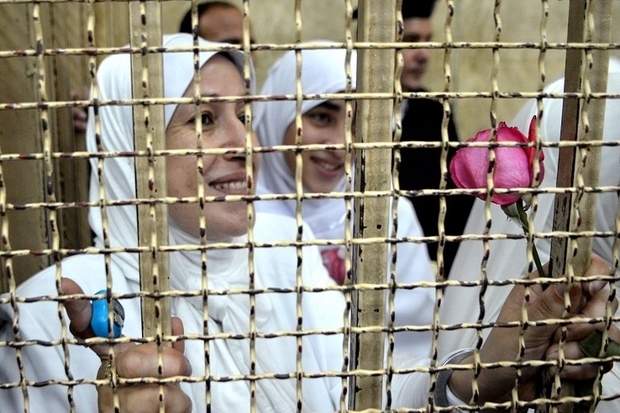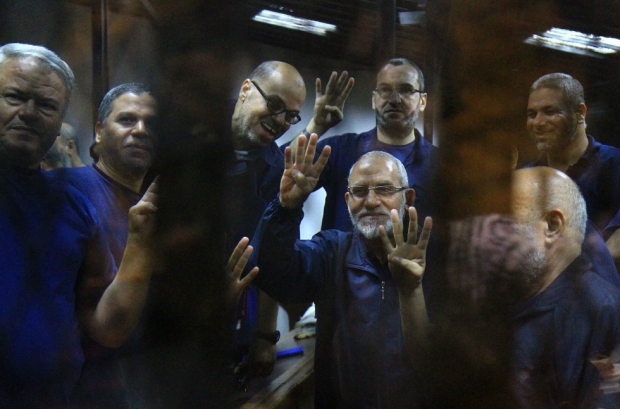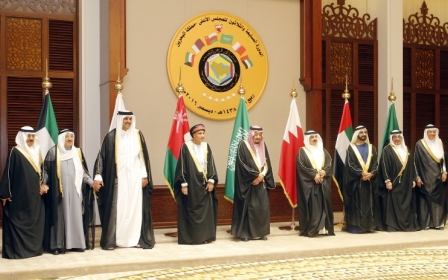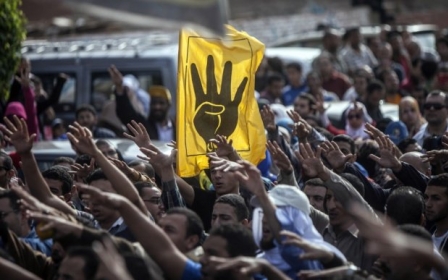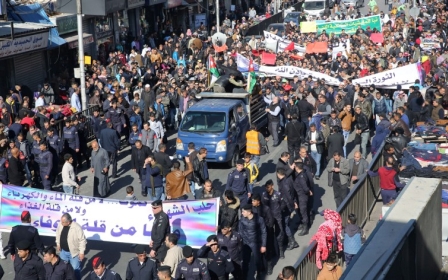
How the Muslim Brotherhood's women activists stepped up in Egypt
Following the military coup in Egypt in July 2013, more than 50,000 members of the Muslim Brotherhood movement have been imprisoned, including the senior leadership.
These vacancies have pushed women activists in the movement to play a bigger role within the organisation, building upon decades of political and organising experiences that have been enriched by the movement's short-lived experience as a political party - the Freedom and Justice Party (FJP) - in Egypt in 2011-2012.
Before the 2011 popular uprising as women activists were demanding greater representation within the movement's structure and hierarchy, at the same time, they were also facing the regime's repression.
The women's growing visibility and activism after the popular uprising have rendered them a target by the state.
A marginal role
Initially, women activists in the Brotherhood had a limited role focusing on social work, such as sheltering poor families. Gradually, they moved into the political realm when under Hosni Mubarak's rule (1982-2011) they increasingly focused on mobilising political and financial support for the imprisoned male members of the group who were deemed a "security threat" by the state.
The Brotherhood's women activists broke new ground when they played an instrumental role in running media campaigns for the movement's candidates during national parliamentary elections in 2005 and in 2010, building on women's access to people via mosques and welfare organisations.
Before the January 2011 popular uprising, women's role was viewed by the government as marginal and, therefore, there were very few occasions when women were targeted by the state repression machine.
With the opening up of the political space between February 2011 and June 2013, the women activists' political engagement expanded even further, both through public activism and within the MB structure
Another contributing factor to the limited role played by women activists before 2011 was the restrictions imposed by the male leadership who did not want to expose women activists to any form of state repression.
The Mubarak regime avoided imprisoning women by using other tactics. For example, in the 2000 elections, when Jihan al-Halafawi, a senior woman activist in Alexandria, ran against the ruling party's candidate, the state tried hard to pressure her to withdraw from the race by arresting her husband, who was also a Brotherhood member and her campaign manager.
Security officials offered to release her husband in exchange for her withdrawal from the elections.
With the opening up of the political space between February 2011 and June 2013, the women activists' political engagement expanded even further, both through public activism and within the MB structure.
Expanding political engagement
The Muslim Brotherhood's women activists served in the FJP's secretariats across Egypt focusing on women's political awareness and media relations committees. They began to ascend to higher leadership positions.
For example, after the presidential elections in June 2012, Omayma Kamel was appointed as a member of the Constituent Assembly delegated with drawing up the constitution and also served as a presidential aide to president Mohamed Morsi.
Moreover, Dina Zakaria was appointed as the spokeswoman for the FJP. As of 2012, the MB allowed women to be elected as heads of the regional women's committees. These committees communicated directly with the Guidance Bureau, the highest decision-making body within the movement. Previously, such positions were held only by men.
However, women still did not hold any senior positions in the FJP or the MB. Sabah al-Sakkari, a member of the party's secretariat who ran for the FJP chairmanship in 2012, failed to obtain the required number of signatures to run in elections.
After the coup, due to the bloody crackdown of President Abdel Fattah el-Sisi’s government against the movement, many women activists moved from organising politically as members of the FJP to organising independently, including working to document and highlight human rights violations.
While their visibility in public political life has made them targets of the state (albeit to a lesser degree than men), it has also made it hard for Muslim Brotherhood leaders to ignore the women's demands
For example, during the Rabaa sit-ins, women activists founded the Women Against the Coup (WAC), the first of several women-only resistance movements established following the 2013 coup and crackdown on the movement. It remains the most active organisation for women's mobilisation across Egypt.
Initially, women would take part in demonstrations, talk to media outlets about the violence inflicted by the regime against the protestors, and report to human rights organisations such as Human Rights Watch on these violations.
For example, Asmaa Shokr, the spokeswoman of the organisation abroad, has been speaking to national and international outlets on the human rights abuses of Sisi’s regime against women.
Documenting human rights abuses
The growing mobilisations of the Muslim Brotherhood's women activists against the state has led to their targeting on 19 July 2013, when security forces killed three women activists in Mansoura who participated in an anti-government demonstration.
Since then, they organised women-only marches in Egypt and in exile. The women activists made violence against women a central theme for sustaining the support for their mobilisation.
Women activists began providing data on cases of violence against women as early as November 2013. Additionally, to increase the impact of their activism and role in the opposition, they allied with prominent leftist organisations that resisted the coup such as the Hisham Mubarak Law Centre, which provided the activists with training in international human rights.
Although many organisations in Egypt abandoned working or reporting on human rights violations against the Brotherhood and the Sisterhood, some even attacked the peaceful protestors and blamed them for being killed.
Women activists have also reached out to international human rights organisations, such as Human Rights Monitor and Insaniya.
Their main work abroad focuses on communicating the reports of human rights abuses against the opposition in Egypt, which is significantly comprised of the MB and their supporters, to the wider international community through interviews with media outlets, sharing their reports with international NGOs such as Amnesty International and on social media outlets such as Facebook and YouTube.
The data for such reports is being collected by women who are still in Egypt.
Ideological divisions
The backlash against the Brotherhood since 2013 has resulted in organisational and ideological divisions within the group over how to respond to Sisi's repression. It has divided the Brotherhood into two factions: the old leadership versus the young revolutionary members.
The division over which strategy to follow to confront Sisi's regime intensified in 2014, following the group's designation as a terrorist organisation.
Although the youth have embraced a confrontational and revolutionary approach, the old leadership adapted a more accommodating position toward addressing regime repression to allow bargaining and reconciliation.
In February 2014, the youth pressured the group to hold internal elections to reform its governing bodies and fill the leadership void after the arrest and exile of a large number of its senior members.
This ideological difference also divided the Sisters, although in lesser numbers. The majority of the women activists sided with the old guard or took a neutral position regarding the division. For example, Asmaa Shokr, a woman activist based in Istanbul, said that she was not supportive of the division, even though she wanted changes to the group's old approach.
In addition to physical repression, the Muslim Sisters have been the target of smear campaigns.
The National Council for Women (NWC), and other institutions with government ties have criticised women's participation in the Rabaa sit-ins, accusing the Brotherhood of "using women and children as human shields", to discredit the Muslim Sisters' activism following President Morsi's overthrow by both denying their agency and accusing them of using terrorist tactics.
An article in the pro-government Egyptian daily Youm 7 further accused the Sisters of "organising terrorist attacks" in Egypt, including the assassination of Attorney-General Hisham Barakat.
Equal players
According to the report, the women's organisation allegedly "receives assignments from abroad through social media, and it communicates this information to the imprisoned Muslim Brotherhood officials who then give coded orders to carry out the terror attacks".
Eventually, in July 2016, the Cairo Court of Urgent Matters banned Women Against the Coup's activities inside Egypt. Now, the organisation is operating from abroad, and some of its founders, such as Asmaa Shokr, live in exile in Turkey with their families.
Yet while their visibility in public political life has made them targets of the state (albeit to a lesser degree than men), it has also made it harder for Muslim Brotherhood leaders to ignore women's demands for a bigger role in the organisation and its structure.
Dina Zakaria, an activist, explained: "When the military coup took place, women took the decision to be part of the resistance. No one can tell [women] to stay at home because they are under threat."
"This led the Egyptian MB in Turkey to consider drafting bylaws in January 2017 to set a quota for women’s participation in the movement’s Shura Council, which functions as both an executive board and a parliament."
Moreover, last year, the Brotherhood elected the first female member of its Shura Council in Turkey. This visibility of their political and social activism, as well as the state's targeting of the Sisters, has made it impossible for the Muslim Brotherhood's male leadership to ignore women activists as equal players.
- Anwar Mhajne is a PhD candidate in political science at the University of Cincinnati. Follow her on Twitter @mhajneam.
The views expressed in this article belong to the author and do not necessarily reflect the editorial policy of Middle East Eye.
Photo: Egyptian women members of the Muslim Brotherhood hold roses as they stand in the defendants' cage dressed in prison issue white during their trial in at the court in the Egyptian Mediterranean city of Alexandria on December 7, 2013 (AFP).
This article is available in French on Middle East Eye French edition.
Middle East Eye propose une couverture et une analyse indépendantes et incomparables du Moyen-Orient, de l’Afrique du Nord et d’autres régions du monde. Pour en savoir plus sur la reprise de ce contenu et les frais qui s’appliquent, veuillez remplir ce formulaire [en anglais]. Pour en savoir plus sur MEE, cliquez ici [en anglais].


